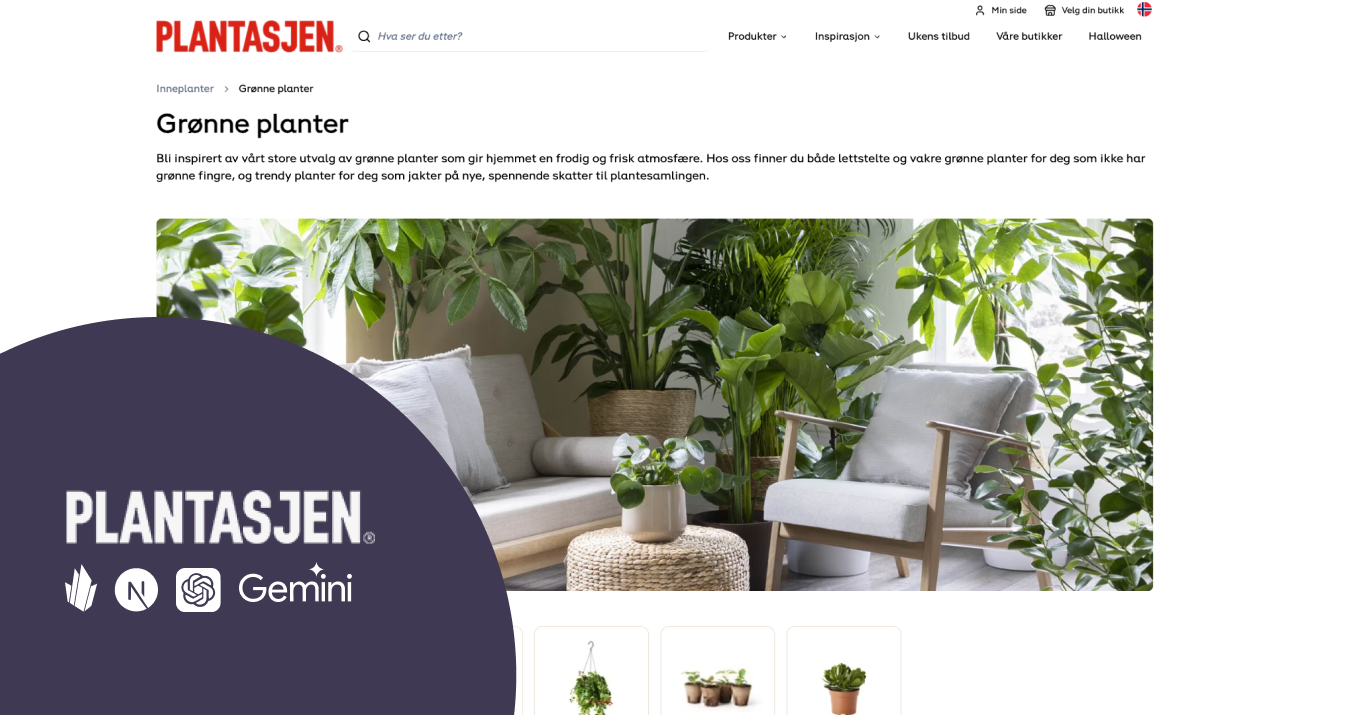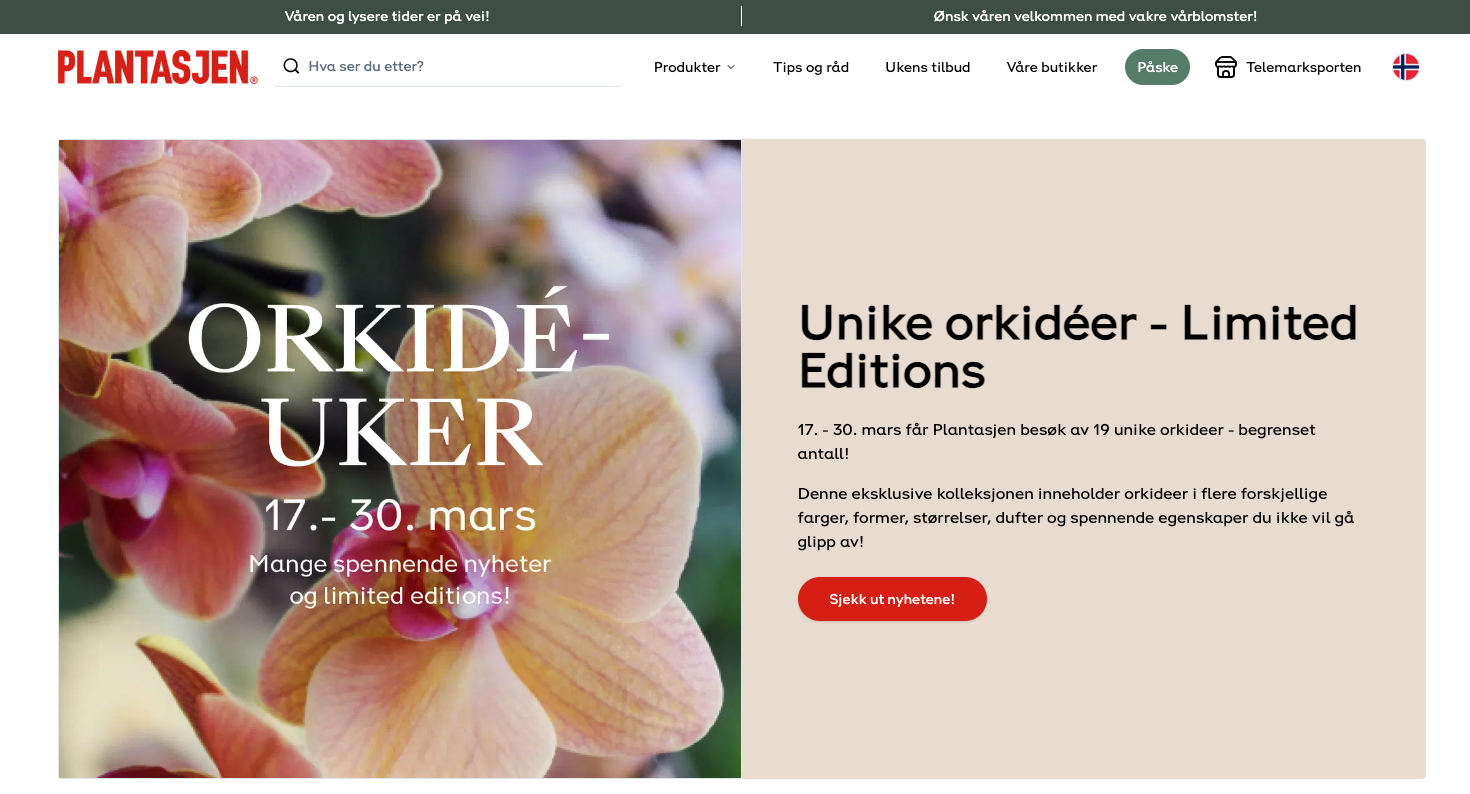Composable Architecture + AI: How Plantasjen Scaled Multi-Market Product Enrichment Without Growing the Team
A headless rebuild anchored on automation and machine intelligence enables fast, flexible, multilingual commerce at scale.

Plantasjen, the Nordic garden-retail leader with around 90 stores across Norway and Sweden and an annual turnover of about NOK 3.5 billion in normal years, found itself at a crossroads. Its core business — nearly 70 % plants and accessories and 30 % complementary garden products (furniture, BBQs, etc.) — was being held back by a legacy digital stack unable to keep pace with seasonal spikes, multilingual needs, and content-rich product storytelling.
From the developer side, the stack was rigid, workflow-heavy, and batch-oriented, slowing product launches, limiting content enrichment, and hampering time-to-market. From the business side, the goals were clear: empower editors with autonomy, cut operational costs, shift from purely transactional to an inspirational digital experience, and introduce easier scaling, especially for the April-June peak.
In response, Plantasjen pursued a complete rebuild anchored on composable architecture and layered in AI-powered workflows. The result: unified product and content data, streamlined editorial pipelines, and a launch cadence that handled 15,000+ SKUs across two markets and three languages without scaling the team.
This case study explores how they bridged business goals and engineering execution to achieve that. And touches on AI automation workflow.
Problem
Plantasjen’s business faced several overlapping pain points. Its peak sales period — April through June — accounts for roughly half of annual revenue, meaning any delay in product launches or content enrichment risks lost opportunity. Meanwhile, the old tech stack (Salesforce Commerce Cloud plus inRiver PIM) was costly, slow to adapt, and created bottlenecks: editors were trapped in manual workflows, data was fragmented, and multilingual operations were complex to scale.
On the engineering side, the monolithic architecture stifled innovation. Manual imports, category-wide batch updates, Excel-based enrichment, and disconnected systems meant a new product could take weeks or even a month to go live. Without a fix, scaling across markets would require adding headcount or managing even more sprawling manual processes — neither acceptable.
When Plantasjen evaluated its next-generation platform strategy, it had to meet both business and technical imperatives. On the business front: scalability, cost efficiency, multi-market/multi-language support, real-time updates, and editorial self-service. On the technical front: modular architecture, clean master data, automation readiness, and future-proof workflows.
Special attention was paid to the AI-piece: the team recognized early that “AI” only delivers if the input data is structured, consistent, and clean (for example, Latin plant names, mandatory taxonomy fields, required attributes rather than open free-text). They also needed workflows that included verification, not fully autonomous publishing, to avoid risk. The dev team balanced speed of rollout with robustness, trade-offs between automation and manual control, and the need to deliver quickly (given seasonal deadlines) while building a system that could scale.
Solution
Plantasjen replaced its legacy stack with a composable, headless commerce platform Crystallize that unified product information, digital assets, workflows, and editorial tools. The new architecture streamlined front-end and back-end processes, enabled rapid updates, and gave content teams control over layout, copy, and multilingual publishing.
However, the true differentiator was how the architecture was paired with automation, especially AI workflows, to drive scalability without scaling the team.
AI in the Workflow
The pipeline begins when master product data (e.g., Latin name, color, size, category attributes) flows into the system. An image-generation flow uses this structured data to create product visuals, which are a strong fit for plants (taxonomy is stable, and visual patterns repeat).
A copy-generation flow creates short and long descriptions, unique selling points, and category-specific guidance (e.g., planting instructions) based on product category logic. After copying and generating a translation flow, it localizes all copy into relevant languages (Norwegian, Swedish, English) while preserving context and ensuring consistency in names/colors across languages.
Each asset and piece of copy is reviewed through an editorial “drag to verify” interface; once verified and publishing criteria are met (price present, market assigned, sales status active), the product is pushed live, often within minutes.
Because the architecture is event-driven, new product entries (from ERP/assortment planner) automatically trigger this AI pipeline, shifting what once took weeks to a one-day or faster cadence.
By embedding these AI-powered flows into an event-driven architecture, Plantasjen transformed its content-to-commerce pipeline: 15,000+ SKUs across two markets and three languages now move through enriched and verified processes without linear increases in headcount.
You can find the complete story on how Plantasjen is transforming product data management using AI automation and Crystallize in this livestream.
Key Takeaways
The Plantasjen case demonstrates that when business goals, developer architecture, and AI workflows align, you can scale smartly, supporting multi-market, multilingual operations with enriched content and fast deployment, without proportional increases in headcount.
Platform costs (licensing and maintenance) were substantially lower compared to the previous stack. This was achieved while managing over 15,000 SKUs across two markets and three languages. Editorial teams can now launch campaigns and new product sets in hours or days, a significant improvement from the previous timeline of weeks or months.
The development team achieved greater efficiency and innovation through a modular and reusable workflow architecture. This eliminated the need to re-architect major flows during iterations. Automated flows with built-in verification steps also replaced manual, category-wide batch updates, allowing the team to dedicate more time to innovation.
If your company is wondering how to scale content + commerce intelligently, the Plantasjen story offers a blueprint: unify your data layer, layer in automation and AI, empower your content teams, and build a stack that scales without breaking.
You can do the same for your business. Seriously, give Crystallize a try!
START building for FREE with Crystallize, or schedule a 1-on-1 demo so we can show you how Crystallize fits your use case.

